Indian Runner 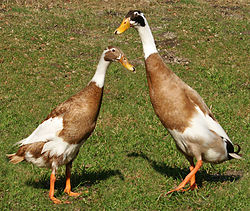
|
| They orient from the Orient.. The unique aspect of Runner ducks is their slender, upright stance. This enables them to move around much more quickly than most other breeds of ducks. Because of their speed and herding instinct, Runners are often used for training sheep dogs. |
| |
|
| |
Khaki Campbell 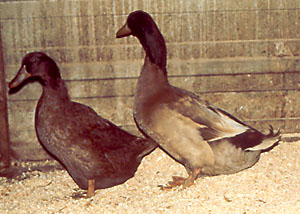
|
| The Khaki Campbell was developed in England at the turn of the century. In small, undisturbed flocks they are very good layers. It earned its reputation as an excellent egg layer in the 20’s and 30’s on the Jansen duck farm in Holland. It is an excellent forager and capable of sitting on and hatching its own eggs. |
| Khaki Campbell ducks are also very colorful. The drakes have brown heads and green bills. The body shades vary from light beige to dark brown. |
|
Muscovy 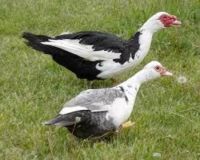 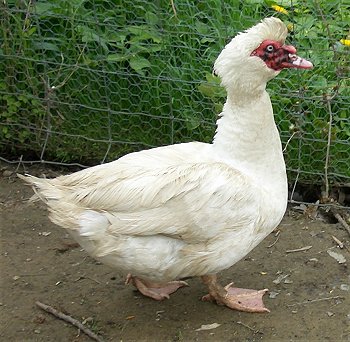
|
| Muscovy ducks come in a wide variety of colors and patterns. They also are not good swimmers–they lack the oil in their feathers that ducks have. They like to dabble in water are excellent flyers (can fly just enough to get up on a barn roof or fence).
They are quiet, but not voiceless. They have been known to attack and kill snakes.
|
|
Pekin 
| This breed was introduced into America in the 1870’s from China. It is by far the most common breed of duck for commercial meat production because of its extremely fast growth rate and good feed conversion (pounds of feed to produce one pound of body weight). They are extremely hardy and found throughout the United States. |
| Pekins are all white ducks with orange bills and feet. They are often known as the Easter duck or barnyard duck. |
| The baby ducklings are cute little yellow fluff balls. |
| Mature Weight: They are very large and weigh approx. 7 lbs. in 8 weeks. |
|
Rouen 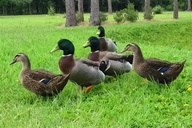
|
|
Rouens were originally bred in France and retain the coloring of the native Mallard and are very beautiful. They are the domestic non-flying cousin of wild Mallard and are second only Pekins and Muscovy in size. They are said to have the most flavorful meat. They are moderate layers with many of their eggs being greenish in color.
|
| They are full grown in 12 weeks. The males are a shade of gray, blue and brown with lustrous green heads and neck, rich purplish brown chest, and steel gray penciling on the upper body.. The females are a tan to dark brown. By 6 weeks of age the bill of the drakes (male duck) are a dull green and the hen’s are dark brown and orange. |
| Mature weight: Males have a fall weight of 8 to 9 pounds and females are 6 to 7 pounds. |
|
| |
| Tips on Brooding and Raising Ducks (click here for more information.) |
| Always use UNMEDICATED Chick Start and Grow. They are easy to raise and very disease resistant and cannot tolerate the medication that is helpful to chickens. Ducklings have a tendency to pick each other to the extent of baring their backs. Another little nasty habit that they can develop is picking at each other’s wings. It you have a goose with the wings bent out, they were the victim of one of their peers snapping their wing and breaking it. It does not hurt the goose as domestic geese don’t fly anyways but they don’t look quite normal. One way to help prevent this from happening is to give them more room and put clumps of grass ( ground and all) in their pens. The grass is also needed daily to help prevent crippled legs. |
| Ducks and Geese : By 6 weeks of age, they are pretty well feathered out, their oil glands are working and they are ready for the big swim. They enjoy a pelleted feed mixed with whole corn. Ducks and Geese naturally eat mostly grass. It does not take much grain to supplement their diet. |
| Contrary to what you might think, you do not need a pond to have ducks. A child’s wading pool works nicely. They like to mate in water and need water to hatch their eggs. They need to be able to get their feathers wet in order to keep their eggs moist. |
| Adult male ducks can be distinguished by a curl on the end of their tail. Domestic ducks, unlike their “wild” cousins can not fly and do not migrate. They may be able to get up in the air enough to clear a fence if frighten and they have enough of a running start. |
|